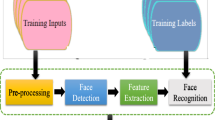Abstract
Because of the rise of deep learning and neural networks, algorithms based on deep learning have also been developed and subtly applied in daily life. This paper hoped to use neural network-based face recognition with absolute distance estimation and research done with drones to achieve the target tracking effect through the recognition ability of neural networks. The aerial images were used to identify different people or behaviors through which distances could be calculated to establish the foundation for subsequent research and development. According to our experiments, performing the face recognition model and distance estimation met expected results, and it also had a specific accuracy rate from different angles and distances. In summary, identification and distance estimate had better accuracy within the effective length, and we could expect the speed and convenience of identification to be realized on other devices.

















Similar content being viewed by others
References
Hsu H-J and Chen K-T (2015) Face recognition on drones: issues and limitations. In: Proceedings of the first workshop on micro aerial vehicle networks, systems, and applications for civilian use
Hsu H-J and Chen K-T (2017) DroneFace: an open dataset for drone research. In: Proceedings of the 8th ACM on multimedia systems conference
Kalra I et al. (2019) Dronesurf: benchmark dataset for drone-based face recognition. In: 2019 14th IEEE international conference on automatic face & gesture recognition (FG 2019). IEEE
Wilson PI, Fernandez J (2006) Facial feature detection using Haar classifiers. J Comput Sci Coll 21(4):127–133
Sarath R N et al (2019) Unmanned aerial vehicle for human tracking using face recognition system. In: 2019 Advances in Science and Engineering Technology International Conferences (ASET). IEEE
Guo G et al. (2003) KNN model-based approach in classification. In: OTM confederated international conferences, on the move to meaningful internet systems. Springer
Dalal N and Triggs B (2005) Histograms of oriented gradients for human detection. In: 2005 IEEE computer society conference on computer vision and pattern recognition (CVPR'05). IEEE
Suykens JA, Vandewalle J (1999) Least squares support vector machine classifiers. Neural Process Lett 9(3):293–300
Kalal Z, Mikolajczyk K, and Matas J (2010) Face-tld: tracking-learning-detection applied to faces. In: 2010 IEEE international conference on image processing. IEEE
Kalal Z et al. (2012) Tracking-learning-detection. 34(7):1409-1422
Taigman Y et al. (2014) Deepface: closing the gap to human-level performance in face verification. In: Proceedings of the IEEE conference on computer vision and pattern recognition
Szegedy C et al. (2017) Inception-v4, inception-resnet and the impact of residual connections on learning. In: Thirty-first AAAI conference on artificial intelligence
Parkhi OM, Vedaldi A and Zisserman A (2015) Deep face recognition
Simonyan K and Zisserman AJAPA (2014) Very deep convolutional networks for large-scale image recognition
Amos B, Ludwiczuk B, and Satyanarayanan MJCSoCS (2016) Openface: a general-purpose face recognition library with mobile applications 6(2)
Schroff F, Kalenichenko D and Philbin J (2015) Facenet: a unified embedding for face recognition and clustering. In: Proceedings of the IEEE conference on computer vision and pattern recognition
Wen Y et al. (2016) A discriminative feature learning approach for deep face recognition. In: European conference on computer vision. Springer
Lucas BD and Kanade T (1981) An iterative image registration technique with an application to stereo vision
Wang L-L, Tsai W-H (1991) Camera calibration by vanishing lines for 3-D computer vision. IEEE Trans Pattern Anal Mach Intell 13(4):370–376
Gil K et al. (2014) AR Petite Theater: augmented reality storybook for supporting children's empathy behavior. In: 2014 IEEE international symposium on mixed and augmented reality-media, art, social science, humanities and design (ISMAR-MASH'D). IEEE
Katz BF et al (2012) NAVIG: augmented reality guidance system for the visually impaired. Virtual Reality 16(4):253–269
Segal J, Kaplan A, and Butler C (2017) Real-time face recognition drone surveillance system
Saha A, Kumar A, and Sahu AK (2018) Face Recognition Drone. In: 2018 3rd international conference for convergence in technology (I2CT). IEEE
Zhang K et al. (2016) Joint face detection and alignment using multitask cascaded convolutional networks 23(10):1499-1503
Cao Z et al. (2018) OpenPose: real-time multi-person 2D pose estimation using Part Affinity Fields
Wei S-E et al. (2016) Convolutional pose machines. In: Proceedings of the IEEE Conference on Computer Vision and Pattern Recognition
Cao Z et al. (2017) Realtime multi-person 2d pose estimation using part affinity fields. In: Proceedings of the IEEE conference on computer vision and pattern recognition
Simon T et al. (2017) Hand keypoint detection in single images using multiview bootstrapping. in CVPR
Hsu L-H (2018) Realtime depth estimation for multiple personsusing single camera and OPENPOSE. In: Computer Science and Engineering. National Taiwan Ocean University: Keelung City. p. 115
Author information
Authors and Affiliations
Corresponding author
Additional information
Publisher's Note
Springer Nature remains neutral with regard to jurisdictional claims in published maps and institutional affiliations.
Rights and permissions
About this article
Cite this article
Pu, YH., Chiu, PS., Tsai, YS. et al. Aerial face recognition and absolute distance estimation using drone and deep learning. J Supercomput 78, 5285–5305 (2022). https://doi.org/10.1007/s11227-021-04088-6
Accepted:
Published:
Issue Date:
DOI: https://doi.org/10.1007/s11227-021-04088-6




